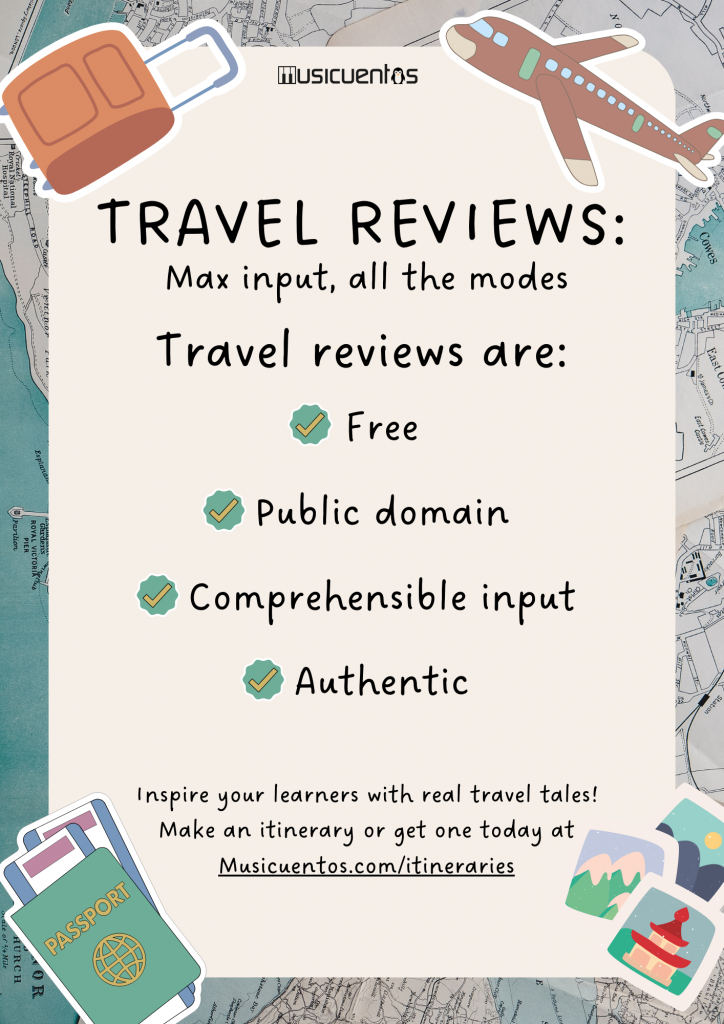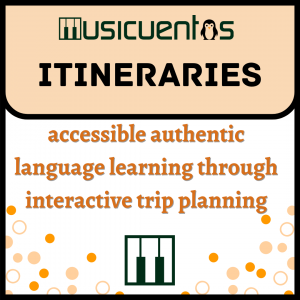It’s a new season for Musicuentos. You know this. You probably also know it’s going to include regular breaking news, like the return of the Musicuentos Monthly newsletter, or the new Facebook group Musicuentos Tips, Tools, & Talk for Spanish Teachers.
My next announcement involves travel itineraries– eventually, for every Spanish-speaking country. My original three itinerary products are moving from TPT to be exclusively available on my site (and spoiler alert, so am I). I want to introduce you to the product, but what I really want to do in this post is to help you discover travel reviews as a source of public domain, comprehensible authentic language for your learners. Let’s discuss: why travel reviews, and what to do with them?
Travel reviews = input gold mine
I discovered how useful TripAdvisor’s Spanish-language reviews were several years ago. It might have been in the year of the death of my creativity when we worked on building our own site of reviews for our city. (See what the kids in Washington, Iowa did with that project!) In any case, it didn’t take me long to realize how useful they were.
1. They’re free.
Inflation’s up, real wages are crashing, and we’re all tightening our budgets. Right now I’m having to pick and document my grocery purchases like I did when my first daughter was born and my husband and I were both working part-time. Who can pass up something free when it comes along? Great news! Spanish-speakers around the world are busily creating free content for you by reviewing their favorite tourist spots every day.
2. They’re public domain.
Some people have learned this the hard way. Some haven’t learned it at all, unfortunately. The rough truth of the internet is that when you publish something for all the world to see (or, to be honest, have a breakdown in public), you’ve relinquished your right to privacy on that content. In certain aspects, you’ve relinquished any right you have to the content itself.
On TripAdvisor, this is a good thing. TripAdvisor holds copyright on their own content, but in scouring all their terms of service, I didn’t find any legal issue with using (and adapting) the content found in reviews. If you know what a stickler I am for copyright violation, you are cheering hurra with me!
In short, you can pretty much do what you want with travel reviews.
3. They’re made to be comprehensible input.
The shortest review on the first page of the Museo Frida Kahlo is 22 words:
Un lugar bellísimo y lleno de historia, imperdible en Coyoacán. Haz tu reservación porque si no es bastante difícil asegurar la entrada!
The longest is 112 words. Sure, some contain phrases like “Sin embargo uno es libre de bajarse en cualquier parada,“ but it’s so easy to find text that’s short, clear, and repetitive, like “definitivamente una gran experiencia.”
You may see a phrase like this:
El personal ha sido muy amable y ha tenido una actitud fantástica.
and you think “ha sido, that’s comprehensible, really?” But- take a closer look. If a learner knows the novice person descriptor amable, the whole sentence is really evident, as far as what it means. As a huge bonus, this sort of exercise can help students face text they may not fully understand with the confidence that they may still get not only something from it, but the actual main idea.
4. They’re truly authentic.
These are Spanish speakers writing for Spanish speakers. They don’t have you and your learners in mind at all. They’ll help you learn some slang, some abbreviations, regional variations, and how to navigate lack of punctuation. You can’t avoid ha sido, but you can learn to navigate it when it’s there.
A couple of gems from that same first page of reviews on the Frida Kahlo museum:
todo su talento wao
en definitiva hizo q le diéramos dinero, tirándoselo x la ventana del pasajero
And don’t negate the magic that can happen when kids are reading real opinions about real places they’ve never heard of. It’s amazing the places you’ll discover together!
So, choose a city, choose a site of interest, perhaps an amusement park, a resort hotel, a street fair, a restaurant. Click on the reviews, and then change the language to Spanish. Find something that will engage and push your learners. Don’t be afraid to cut incomprehensible pieces or combine reviews to make a longer text that offers more language, but I encourage you not to mess with the language too much. If you do, it’s no longer authentic. For sure there are totally incomprehensible reviews in the mix – skip them and keep going. You’ll find some gold in there, I’m sure of it!
Travel itinerary = all modes + high interest
When you combine reviews into a travel itinerary the way I have in my new itinerary downloads, you’re taking an authentic resource and making into so much more than interpretive reading.
DISCOVER AND PURCHASE A MUSICUENTOS TRIP ITINERARY
Let me give you an overview of how my trip itinerary activities work.
1.Explore multiple cities, and multiple sites in each.
For most of these itineraries, there are four major cities/areas in each. In Mexico, learners explore San Luis Potosí, Guadalajara, CDMX, and Mérida.
Within each city, there are three categories of places. It might be a restaurant, a nature excursion, and a museum. Or it might be a beach, a cathedral, and a hotel.
2. Side-by-side reviews ask for a choice.
Learners will choose which location they will visit based on the review. For example, they read reviews on two different museums in Bogotá, and based on the review, choose which museum to visit.
3. After the choice, give a reason.
In the document, learners write their choice and defend it using reasons from the review. This adds a presentational writing task.
As they work through the reviews, consider adding interpersonal tasks. For example, start by asking kids to stand here if you chose this museum, stand there if you chose the other. Then, ask for simple reasons. Model questions and answers about reasons and changing one’s mind. Finally, give learners an opportunity to convince someone who chose the other museum to change her/his mind.
4. Front-load (& follow up) using your favorite strategies.
Every itinerary resource includes a list of useful/new vocabulary that will appear in the reviews. Often, these words appear multiple times (think how much you might see ambiente or caro). Front-load the activity by using a variety of strategies to introduce the vocabulary. The list at the beginning is in Spanish only, but there’s a glossary with translations at the end.
If you teach with storytelling, consider taking a day per city and telling a story in which you place a character in the city and the character finds him/herself in funny situations choosing one place over the other. In this way, students will be primed to read the reviews about the actual place and choose.
You can also show or ask students to watch at home a video on the place(s). One of my favorite resources is “eating in X place with only Y amount of money.” These are great!
Also, asking students to present their choices and reasons to a small group or the whole class, especially if they can only use a card with key words, adds an element of presentational speaking.
4. Pair with a country focus or comprehensible reader.
I started making these for broad use to accompany learner novels we were reading in class. Use an itinerary as a culminating project for a unit on Costa Rica, or a learner novel set in Colombia such as Peter va a Colombia. Consider assigning the preliminary plans and each day’s choices to prescribed dates and having learners present their itineraries as a unit-end or semester-end project. Honestly, doing the whole thing at once is a bit of overkill on the same skills; it’ll be a lot more engaging and useful if you spread it out a bit.
5. Use as anything from a sub plan to a unit assessment.
As I mentioned, you can stagger the activities over a unit of just about any length. It’s also a great option for a sudden sub plan.
Because it lends itself to all the modes, if you’re making a unit out of this specific country and the travel / opinion vocabulary it contains, the itinerary makes a really good unit assessment. You can do three days together as a class activity and then give the fourth day as your assessment. Don’t forget to ask for an interpretive task (negotiate agreement on which one to use and why) and a presentational task (present your itinerary including reasons) to add to the reading (and you could throw in a video task in there for fun, too).
When time and creativity fail, I’ve really appreciated the authentic, public-domain, high-interest material that’s there for the taking in travel reviews. It’s saved me a lot of work. Hope over to the Travel Itinerary Shop and let me save you some work, too.





